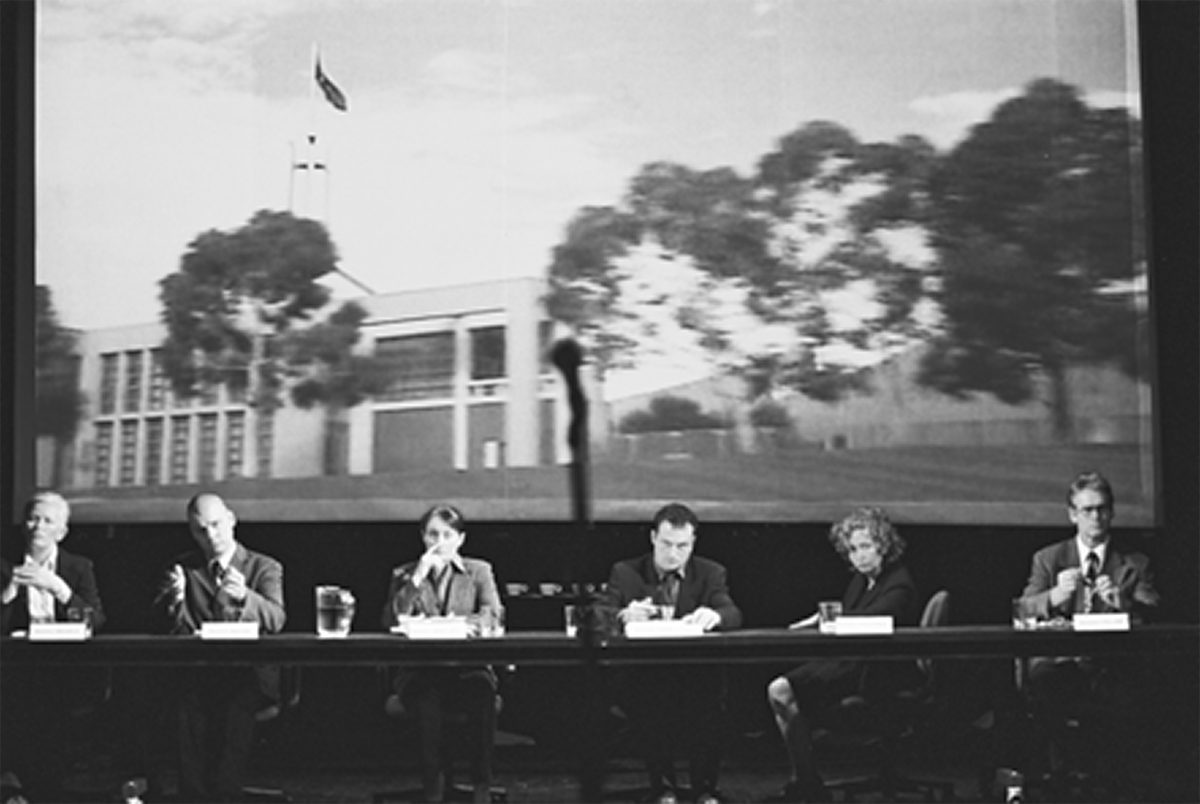Version 1.0 shares the shame
Bryoni Trezise
In 2002 a Senate Select Committee assembled to investigate claims that the Australian Government had lied to the public over the children overboard affair in the lead up to the 2001 election. The full-house season of CMI—A Certain Maritime Incident is Version 1.0’s latest assault on the “sweaty armpits of the Australian body corporate”, their very own performative inquiry into the murky waters of evidential hearsay and political obfuscation that the 15 days of Senate hearings and 2,200 pages of Hansard produced.
The provocation of CMI lies both in the inflammatory political situation it deals with and the fact that, as performance, it is attempting to critique the very real political machinations that caused the Tampa situation to develop. In this sense, the political theatrics of the nation’s border ‘protection’ measures as played out by Tampa come to bear quite profoundly on questions such as how—and who—are we to engage in a performance of the national shame in which we are all to some degree complicit? It is tricky and dangerous territory. While politicians are masters of playing fiction as truth, of blurring the line between events as they happened and as they were imagined, performers in this context must be careful at every step to tread in just the right places.
Meet then, Peter Reith, roughly 7 years old, reading his statement as to the ‘veracity’ of children being thrown overboard (very cutely spoken into a lie detector by the young performer). As an introductory motif delivered before the backdrop of an inverted Australian flag, the child’s recitation functions as more than a moment of wry mockery. It establishes a performance code in which voices and gestures sifted from the Senate transcript are assumed, dropped and wrestled with as a way of imagining the kind of dubious political operations that can make national headlines alternately happen or disappear.
The performers themselves strike an exquisitely ambiguous relationship to their personas. Not quite complete characters, their tentative attempts at boardroom mannerisms—a pen twiddle, a cup stir, water pouring from a jug—catch us on that peculiar cusp of watching self-consciously coded physicalities and wanting to fall into the world they suggest. Likewise, their repeated spinning on chairs, signalling a comic tedium in the business of Senate proceedings, becomes poetically suggestive of anonymous bodies spiralling into unknown depths.
Samuel James’ widescreen video montage also holds its subject matter at an ambivalent distance. Circling Parliament House like a shark bearing down on its prey, then moving to the grainy interiors of an unnamed vessel at sea, the footage at once indicts the sites in which alleged events occurred and probes them as producers of fictitious national history. Within the theatre proper James’ camera turns its live eye on the performers, positioning their bodies as objects that at any moment can let slip the game.
One very long table pinions the Senators to their lengthy process, yet also spins in the space like a ship giddily changing course. The table lurches alongside the linguistic rhythms of a political charade that is decontextualised and now exists in “quotation marks.” We hear the ridiculous scrapings for definitions that separate recollection from narration, judgement from description. We witness the shield that language becomes as it writes bodies into acronyms such as SUNC (Suspected Un-authorised Non-Citizen) or PII (Potential Illegal Immigrant). We start in horror at the legislative logic that differentiates “these people” from “our culture” in a mission to find an “achievable and warranted” black and white answer.
Punctuated by projected meta-commentary and set against pop that emulates 1980s corporate musak, the performers undercut the sinister rhetorical backflips of the transcript with moments of comic fabrication. They waltz in a medley of mobile phone banter and militantly perform an aerobics class led by Senator Jane Halton. At the peak of their debauchery, a performer lists the group’s rehearsal strategies: “pick a witness…play with storytelling modes…make it boring…make it up.” As Serge Gainsbourg’s sleazy Je t’aime oozes into this heady, drunken climax of Senators toasting “professionalism”, their fluid and flailing antics of invention are starkly cut dry by the final and very real allegations regarding Australia’s involvement in the sinking of SIEV X, in which 353 asylum seekers drowned. As the closing computerised voice of one SIEV X survivor flashes in subtitles across the screen, describing the real horror of the event, it seems that in this party the job of ‘making it up’ carries a heavy responsibility.
So, do we exit politically charged? Do we exit emotionally gutted, paled by the final voice we hear? I admit I twinged with a grim satisfaction. My cheeks rosy from the electric zing of good performance, my political sensibility gorged on the cynical grotesquery that hacks at politicians and makes them swim (or drown) in their own acronymic juices. I wondered what it means exactly to take pleasure in great art that deals with horrific national policy, and even more horrific events. If performance can ‘do’ politics, creating a world in which Senators play their own witnesses is surely how it should be done.
–
Version 1.0, CMI – A Certain Maritime Incident; performers Danielle Antaki, Stephen Klinder, Nikki Heywood, Deborah Pollard, Christopher Ryan, David Williams; lighting and production Simon Wise, video and design Sam James, dramaturg Paul Dwyer, sound design Jason Sweeney; Performance Space, Sydney, March 26-April 11
RealTime issue #61 June-July 2004 pg. 6







